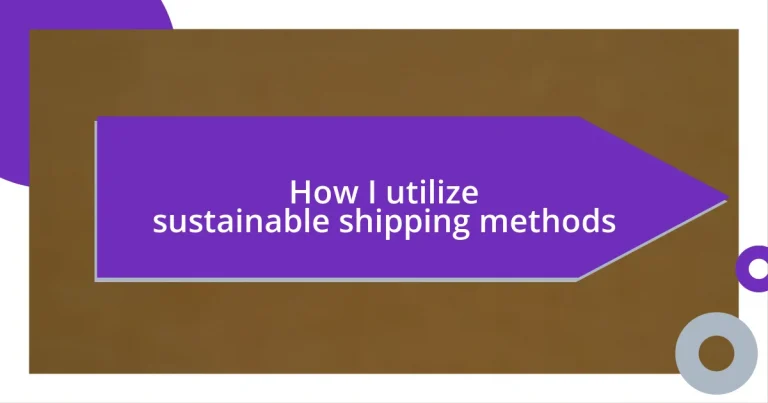Key takeaways:
- Sustainable shipping methods focus on reducing carbon footprints via renewable energy, optimized routes, and eco-friendly packaging, benefiting both the planet and brand image.
- Key benefits of sustainable shipping include cost savings, increased brand loyalty, compliance with regulations, market differentiation, and positive environmental impacts.
- Future trends in sustainable shipping involve innovative technologies like drones, the transition to bioplastics, and collaborative efforts among companies to enhance efficiency and reduce emissions.

Understanding sustainable shipping methods
Sustainable shipping methods are all about reducing the carbon footprint of transporting goods. I remember the first time I learned about eco-friendly packaging alternatives; it made me rethink every delivery I received. Why stick to traditional methods when there are greener options that not only benefit the planet but can also enhance brand image?
When we talk about sustainability in shipping, it often involves using renewable energy sources, optimizing routes, and selecting ships designed for efficiency. I’ve often wondered how companies could actively contribute to a healthier planet and still meet customer demands. It turns out that, with modern technology, they can refine operations to cut down emissions.
Additionally, the push for sustainable practices in shipping isn’t just a trend; it’s a movement that resonates with consumers who increasingly value corporate responsibility. Reflecting on my own purchasing decisions, I feel a sense of pride when I choose businesses that prioritize the environment. Have you ever felt the same satisfaction when knowing your choices align with your values?

Benefits of sustainable shipping
Sustainable shipping offers a plethora of benefits that go beyond merely being eco-friendly. I distinctly remember a conversation I had with a friend who runs a small e-commerce store. He shared how adopting sustainable practices not only lowered his shipping costs through optimized routes but also attracted a loyal customer base eager to support his commitment to the environment. This experience really sparked my interest in the tangible advantages of going green in logistics.
Here are a few key benefits of sustainable shipping:
- Cost Savings: Efficient routes and energy-efficient vehicles reduce fuel expenses.
- Brand Loyalty: Consumers feel more connected to companies that prioritize ecological responsibility.
- Regulatory Advantages: Adopting sustainable methods can prepare businesses for stricter environmental laws.
- Market Differentiation: Standing out as a green company can enhance competitive edge.
- Positive Environmental Impact: Reducing carbon footprints contributes to healthier ecosystems and communities.
Reflecting on these points, I often think about how a few simple changes in shipping practices can create a ripple effect of sustainability, benefiting not just businesses, but the wider community as well.

Evaluating your shipping options
Evaluating your shipping options requires a careful consideration of various factors that influence both sustainability and efficiency. I vividly recall the time I decided to compare different shipping carriers for my online purchases. I was genuinely surprised at how some companies offered carbon-neutral shipping for just a slight increase in cost. Choosing such options made me feel like I was actively participating in reducing my carbon footprint.
When assessing your shipping methods, it’s essential to look at not only the costs but also the environmental impact of each option. Recently, I had to decide between a traditional delivery service and a newer, eco-focused company. The difference in their operations was stark: the eco-friendly service used electric vehicles and offered recycling programs for packaging. It made me realize that these choices, while sometimes presenting a higher upfront cost, could lead to greater long-term benefits for our planet.
I believe that evaluating shipping options should also involve some introspection about what aligns with your values. As I navigated various choices, I found myself drawn to businesses that made their sustainability efforts known through transparent practices. If you’re also considering which shipping methods to adopt, think about how your decisions resonate with your personal beliefs and the message you want to send to your customers.
| Shipping Carrier | Environmental Impact |
|---|---|
| Traditional Carrier | High emissions, standard packaging |
| Eco-Friendly Carrier | Carbon-neutral, sustainable materials |

Implementing eco-friendly packaging
Implementing eco-friendly packaging has been a game changer for my shipping practices. Not too long ago, I transitioned from traditional plastic mailers to biodegradable options. The first time I unpacked a shipment wrapped in eco-friendly material, I felt a wave of warmth knowing I was making a difference, however small it seemed. It made me wonder: how many people are unaware of the impacts of their packaging choices?
In my experience, the switch to recyclable packing materials not only reduced waste but enhanced my customers’ unboxing experience. I still recall the feedback I received after a customer expressed delight over receiving their order in vibrant, fully compostable packing peanuts— such a departure from the usual styrofoam! It was a simple yet powerful reminder of how packaging can reflect a brand’s values and resonate with consumers who prioritize sustainability.
Additionally, I’ve started to include notes with my shipments, encouraging customers to recycle or reuse the packaging. I believe it’s a small part of fostering a connection with those receiving my products. Doesn’t it feel great to be part of a community that values sustainability? By sharing this commitment through packaging, I find I’m not just shipping products; I’m planting the seeds for a greener future.

Choosing the right carriers
Choosing the right shipping carriers is crucial for sustainable shipping. I remember when I first explored this aspect of my business. I was genuinely surprised to discover how different carriers approached sustainability. Some provided valuable carbon offset programs, while others had impressive commitments to reducing emissions. It made me think: how often do we overlook these details in favor of the cheapest option?
One time, I opted for a lesser-known carrier that specialized in eco-friendly practices, and I was amazed at how their approach reshaped my perceptions of reliability in shipping. They not only delivered my packages on time, but they also provided real-time tracking, which eased my anxiety as a business owner. It reminded me that sustainability doesn’t have to compromise efficiency; it can enhance it.
As I navigated my choices, I realized the importance of aligning my values with those of my carriers. I once had a conversation with a shipping representative who was passionate about sustainability, sharing stories of their initiatives. That connection made me feel like I was part of a bigger movement, where each shipment was a step toward a more sustainable future. Have you ever felt that kind of connection with a service you use? It’s invigorating, isn’t it?

Monitoring and measuring shipping impact
Understanding the impact of my shipping choices has been an eye-opening journey. In the beginning, I started tracking the carbon footprint of my shipments, and I realized just how significant those numbers could be. For instance, when I first compared standard shipping to options that focused on reducing emissions, the data revealed a startling difference that simply couldn’t be ignored.
I often find myself reflecting on the information gained from monitoring shipping metrics. It’s fascinating how small changes in packaging weight or shipping distance can have ripple effects on overall sustainability. I remember adjusting my shipping zones based on this data, which not only reduced emissions but also cut costs. It was a win-win situation, leaving me with a sense of accomplishment. Does that not inspire you to look closer at your own shipping practices?
Furthermore, I’ve started utilizing software tools that track my shipping footprint over time. This has added a layer of accountability to my practices. Tracking trends in shipping efficiency not only informs my decisions but also motivates me to continue improving. Seeing those numbers change has been empowering, proof that my efforts are making a genuine difference while also resonating well with my customers. Have you ever used data to make decisions in your own business? The insights can truly be transformative!

Future trends in sustainable shipping
As I look to the future of sustainable shipping, I can’t help but feel a growing excitement about emerging technologies. One intriguing trend is the use of drones for delivery; I remember attending a local seminar where a speaker showcased how drones could significantly reduce carbon emissions during transportation. Imagine the possibilities: a world where local deliveries are made in minutes while leaving a minimal ecological footprint. Doesn’t that sound revolutionary?
Moreover, I’ve been following the conversation around bioplastics in packaging. Just recently, I read about a company that’s started transitioning away from traditional plastics to compostable alternatives. The idea of contributing to a circular economy not only resonates with me but also aligns with my commitment to sustainability. It left me pondering: how can we all adopt similar policies to create a lasting impact?
Finally, I can’t shake the feeling that collaboration will play a pivotal role in sustainable shipping’s evolution. I’ve seen partnerships between companies pooling their resources to share transportation and reduce overall emissions. When I heard about it, I thought: why don’t we all work together for a greener future? The idea of collective responsibility in shipping makes me hopeful, reminding me that individual actions can lead to significant changes when combined. How often do we consider the power of working together to enhance our sustainability efforts?














